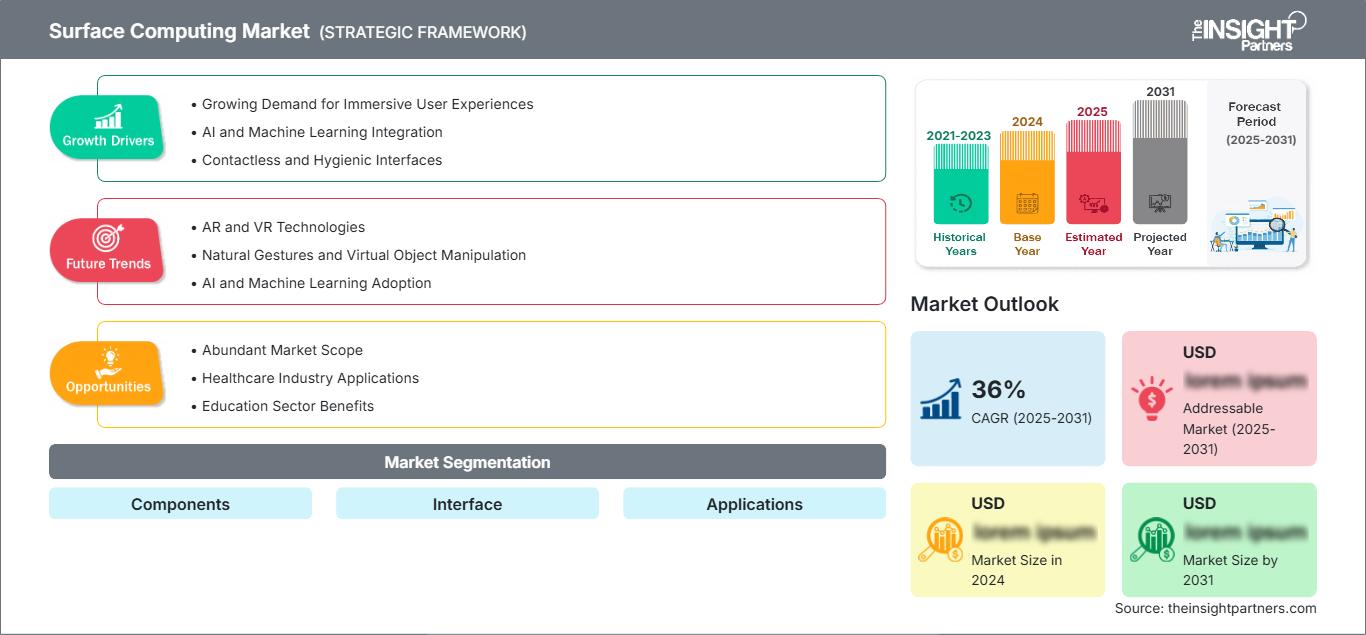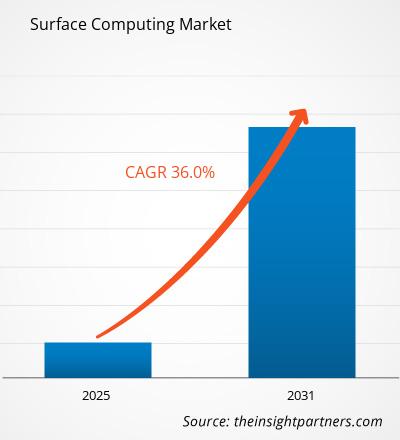Se espera que el tamaño del mercado de computación de superficie alcance los US$ 2012,55 mil millones para 2031. Se anticipa que el mercado registre una CAGR del 30,3% durante 2025-2031.
El informe de investigación de mercado de Computación de Superficie está segmentado por componentes en varios subsegmentos. El informe también ofrece un análisis basado en tipos de interfaz y aplicaciones, incluyendo sectores como el académico y el corporativo. El análisis global se desglosa a nivel regional y por países principales. La evaluación del mercado se presenta en dólares estadounidenses para el análisis segmentario mencionado.
Propósito del Informe
El informe "Mercado de Computación de Superficie" de The Insight Partners busca describir el panorama actual y el crecimiento futuro, los principales factores impulsores, los desafíos y las oportunidades. Esto proporcionará información a diversas partes interesadas del negocio, como:
- Proveedores/fabricantes de tecnología: Para comprender la dinámica cambiante del mercado y conocer las oportunidades potenciales de crecimiento, lo que les permitirá tomar decisiones estratégicas informadas.
- Inversores: Realizar un análisis exhaustivo de tendencias respecto a la tasa de crecimiento del mercado, las proyecciones financieras del mercado y las oportunidades que existen en toda la cadena de valor.
- Órganos reguladores: Regular las políticas y las actividades policiales en el mercado con el objetivo de minimizar el abuso, preservar la confianza de los inversores y defender la integridad y estabilidad del mercado.
Componentes de la segmentación del mercado de computación de superficie
Interfaz
Aplicaciones
Geografía
- América del norte
- Europa
- Asia-Pacífico
- América del Sur y Central
- Oriente Medio y África
Obtendrá personalización en cualquier informe, sin cargo, incluidas partes de este informe o análisis a nivel de país, paquete de datos de Excel, así como también grandes ofertas y descuentos para empresas emergentes y universidades.
Mercado de computación de superficie: Perspectivas estratégicas

- Obtenga las principales tendencias clave del mercado de este informe.Esta muestra GRATUITA incluirá análisis de datos, desde tendencias del mercado hasta estimaciones y pronósticos.
Factores que impulsan el crecimiento del mercado de la computación de superficie
- Creciente demanda de experiencias de usuario inmersivas: la creciente necesidad de formas intuitivas y atractivas de interactuar con el contenido digital está impulsando la demanda de computación de superficie.
- Integración de IA y aprendizaje automático: el avance de las tecnologías de IA y aprendizaje automático mejora los sistemas de computación de superficie, lo que permite interacciones inteligentes y personalizadas.
- Interfaces higiénicas y sin contacto: la naturaleza higiénica de las interfaces sin contacto, que cobraron importancia después del COVID, se alinea bien con el crecimiento de la computación de superficie.
- Avances tecnológicos y reducción de costos: las mejoras continuas en la tecnología y la disminución de los costos están acelerando el crecimiento del mercado de la computación de superficie.
Tendencias futuras del mercado de computación de superficie
- Tecnologías AR y VR: la realidad aumentada (AR) y la realidad virtual (VR) continuarán mejorando la computación de superficie, proporcionando experiencias de usuario inmersivas e interactivas.
- Gestos naturales y manipulación de objetos virtuales: la computación de superficie permitirá a los usuarios manipular objetos virtuales a través de gestos naturales, fusionando los mundos físico y digital de formas innovadoras.
- Adopción de IA y aprendizaje automático: una mayor integración de IA y aprendizaje automático hará que la computación de superficie sea más intuitiva y personalizada al comprender mejor la intención del usuario.
- Soluciones respetuosas con el medio ambiente: la creciente conciencia impulsará el desarrollo de pantallas de bajo consumo y tecnologías de aprovechamiento de energía para una computación de superficie más sostenible.
Oportunidades de mercado en la computación de superficie
- Amplio alcance de mercado: el mercado de la computación de superficie ofrece vastas oportunidades para las empresas y los innovadores, con nuevas aplicaciones emergentes en diversas industrias.
- Aplicaciones en la industria de la salud: La computación de superficie puede mejorar la educación médica, los procedimientos quirúrgicos y la atención al paciente a través de tecnologías interactivas e inmersivas.
- Beneficios para el sector educativo: En la educación, la computación de superficie fomenta la creatividad y las experiencias de aprendizaje interactivas, promoviendo la participación de los estudiantes.
- Innovación en la industria minorista: la computación de superficie permite recomendaciones de productos personalizadas y mejora la interacción del cliente con las exhibiciones de productos en el espacio minorista.
Perspectivas regionales del mercado de computación de superficie
Los analistas de The Insight Partners han explicado detalladamente las tendencias y los factores regionales que influyen en el mercado de la computación de superficie durante el período de pronóstico. Esta sección también analiza los segmentos y la geografía del mercado de la computación de superficie en América del Norte, Europa, Asia Pacífico, Oriente Medio y África, y América del Sur y Central.
Alcance del informe de mercado de computación de superficie
| Atributo del informe | Detalles |
|---|---|
| Tamaño del mercado en 2024 | XX mil millones de dólares estadounidenses |
| Tamaño del mercado en 2031 | US$ 2012.55 mil millones |
| CAGR global (2025-2031) | 30,3% |
| Datos históricos | 2021-2023 |
| Período de pronóstico | 2025-2031 |
| Segmentos cubiertos | Por componentes Por interfaz Por aplicaciones |
| Regiones y países cubiertos | América del norte
|
| Líderes del mercado y perfiles de empresas clave |
|
Densidad de actores del mercado de computación de superficie: comprensión de su impacto en la dinámica empresarial
El mercado de la computación de superficie está creciendo rápidamente, impulsado por la creciente demanda de los usuarios finales debido a factores como la evolución de las preferencias de los consumidores, los avances tecnológicos y un mayor conocimiento de las ventajas del producto. A medida que aumenta la demanda, las empresas amplían su oferta, innovan para satisfacer las necesidades de los consumidores y aprovechan las tendencias emergentes, lo que impulsa aún más el crecimiento del mercado.

- Obtenga una descripción general de los principales actores clave del mercado de Surface Computing
Puntos clave de venta
- Cobertura integral: el informe cubre de manera integral el análisis de productos, servicios, tipos y usuarios finales del mercado de computación de superficie, proporcionando un panorama holístico.
- Análisis de expertos: el informe se compila con base en el conocimiento profundo de expertos y analistas de la industria.
- Información actualizada: El informe asegura relevancia comercial debido a su cobertura de información reciente y tendencias de datos.
- Opciones de personalización: este informe se puede personalizar para satisfacer los requisitos específicos del cliente y adaptarse adecuadamente a las estrategias comerciales.
Por lo tanto, el informe de investigación sobre el mercado de la computación de superficie puede ayudar a descifrar y comprender el panorama de la industria y sus perspectivas de crecimiento. Si bien existen algunas preocupaciones válidas, las ventajas generales de este informe tienden a superar las desventajas.
- Análisis histórico (2 años), año base, pronóstico (7 años) con CAGR
- Análisis PEST y FODA
- Tamaño del mercado, valor/volumen: global, regional y nacional
- Industria y panorama competitivo
- Conjunto de datos de Excel
Informes recientes
Testimonios
Razón para comprar
- Toma de decisiones informada
- Comprensión de la dinámica del mercado
- Análisis competitivo
- Información sobre clientes
- Pronósticos del mercado
- Mitigación de riesgos
- Planificación estratégica
- Justificación de la inversión
- Identificación de mercados emergentes
- Mejora de las estrategias de marketing
- Impulso de la eficiencia operativa
- Alineación con las tendencias regulatorias




















 Obtenga una muestra gratuita para - Mercado de computación de superficie
Obtenga una muestra gratuita para - Mercado de computación de superficie